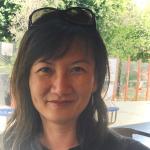SCEC2020: A new platform for science collaboration
The annual meeting is critical to SCEC’s mission. But the year is 2020. Travel is restricted, and everyone is socially distancing. We held out hope as long as reasonable for a Palm Springs gathering. Finally in July the sobering decision was made: SCEC2020 had to move completely online. Would this annual meeting be one to forget once life returns to normal? Or could it be its own unique experience and an opportunity for SCEC to forge another frontier?
The SCEC team was determined to make SCEC2020 one to remember. For all the right reasons.
With precious little time to prepare, we had to improvise. But in the same way a jazz musician would—with wicked skills, imagination, and by listening for audience feedback.
 |
|
SCEC2020 live website: Meeting participants could join plenary sessions, |
The SCEC annual meeting is where the annual science plan is formulated, where the community gives input into the plan before it is finalized. It is where individuals and groups are recruited to participate in the Center’s research program. It is where friendships and collaborations begin and are strengthened, science directions realigned, and SCEC’s esprit de corps is on full display for veterans and new attendees alike. In a typical year, over 500 people gather in the desert mid-September in an over air-conditioned Palm Springs hotel. Over the course of four days we would discuss, debate, and set priorities for SCEC during plenary and poster sessions, leadership meetings, science workshops, field trips, project coordination meetings, and a multitude of other synergistic activities.
At its core, the SCEC annual meeting is a collaboration meeting. To collaborate effectively over many time zones, people need a common purpose and multiple ways to communicate. As a distributed research center, SCEC often operates in this mode. The SCEC community is adept at integrating new information and pivoting quickly to take advantage of emerging opportunities as we steer our science activities year-by-year. That’s why the meetings held before SCEC2020 (the leadership meetings, science workshops, and project meetings) readily transitioned to the online mode. We could tap into these valuable experiences to create the new meeting platform. While the annual meeting’s scope and size presented interesting challenges, it also gave us an opportunity to develop new online capabilities for the SCEC collaboration.
For SCEC2020, we would need to engage 630 people online for four days straight to support the Center's mission. We knew we could count on the SCEC community’s desire to get together to share results and willingness to experiment with new technologies. The pandemic has turned us into Zoom superusers. The need to work and teach remotely, to stay connected with family and friends at a distance, means we now make videos and share content online regularly. These skills were leveraged to improvise solutions for the online poster and plenary sessions.
 |
|
SCEC2020 online poster: Abstract and comments section not shown. |
The poster room is where SCEC science happens at the annual meeting. We wanted to create a similar space where people could interact naturally and contribute in meaningful ways. And we wanted to build capabilities that could be used to improve future events.
We adopted tools already familiar to participants in order to flatten the learning curve. People could then focus their valuable time in sharing results and discussing earthquake science, not mastering a new platform. By integrating Zoom, YouTube and the latest web technologies, SCEC’s software engineer Edric Pauk (and sole web developer for SCEC2020), transformed the SCEC website into an innovative meeting platform that was deceptively simple to use. With a click of a button on the meeting website, people could browse posters, move quickly from one active poster discussion to another, or join the plenary session to see an invited talk.
More than 230 posters were exhibited live from September 14-17, 2020. The online poster gallery featured the breadth of our community’s research and activities in support of SCEC's priorities. The presenters created hundreds of videos to accompany their posters—explaining new results, methods, and research tools to meeting participants. During SCEC2020, visitors to the posters left feedback and comments and joined live discussions in dedicated Zoom rooms.
The plenary sessions began with the State of SCEC address from the director, followed by remarks from our sponsors, and highlights of SCEC5 research, education and outreach activities. Seven science sessions during the four days focused our attention on understanding earthquake precursors, applications for AI in earthquake science, advances in seismic hazard analysis, the 2019 Ridgecrest earthquake sequence, hazard and risk to distributed infrastructure, new directions for earthquake science, and the future of SCEC science.
 |
|
SCEC2020 plenary sessions: Conducted as Zoom "large meetings" for broad audience participation. |
We conducted plenary sessions as Zoom “large meetings”, instead of webinars which limit people’s ability to interact with each other. It was important for participants to see and chat with one another during the sessions. Talks were pre-recorded which allowed presenters to respond to questions live in the chat window during the screening. People communicated and provided input using video/voice, chat, and by answering polls. As with our in-person meetings—and especially now during the pandemic—we needed as many opportunities as possible to connect with colleagues and friends, and to welcome people to the SCEC community. The SCEC2020 platform gave us the means to do that effectively and efficiently.
The feedback from meeting attendees has been overwhelmingly positive. SCEC2020 exceeded by far any experiences had by researchers and sponsors alike at similar online events. Several participants commented that the online meeting features and capabilities set the “gold standard” for other organizations to aim for. Together, and with great skill and creativity, we all improvised solutions that will persist beyond SCEC2020 and created an annual meeting that will be remembered fondly.
But as one person noted, “Despite this being by far the best virtual meeting I’ve ever been to, I do hope that next year we may meet in Palm Springs.”
About the Authors
 |
Tran Huynh is the SCEC Associate Director for Science Operations, working to promote research collaborations across organizations and to align short-term science priorities and business strategies with SCEC’s long-term goals. With the help of her team, she manages the development of SCEC’s collaborative tools and web presence, and allocation of resources for researchers to participate in the SCEC collaboration. |
 |
Edric Pauk is a SCEC software engineer and lead developer of the Center’s Community Information System (CIS). This system supports SCEC’s annual science and collaboration planning processes, including proposal submissions and reviews, subawards, project reporting, publications, workshops, and annual meetings. He also collaborates with scientists and research programmers to create web utilities that enable access to SCEC science project information, datasets, and other products. |
Acknowledgements
The Southern California Earthquake Center is funded by NSF Cooperative Agreement EAR-1600087 and USGS Cooperative Agreement G17AC00047. Additional support is provided by NASA Grant 80NSSC19K0739, DOE Grant DE-SC0016520, W.M. Keck Foundation Grant 005590-00001, and the Pacific Gas and Electric Company. We thank our SCEC colleagues for collaborating in the Center research program and sharing your work at the 2020 SCEC Annual Meeting.



